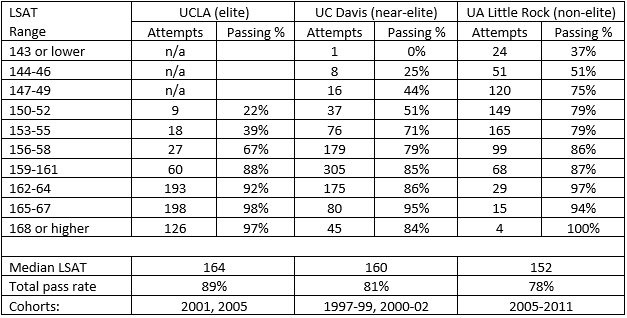The Volokh Conspiracy
Mostly law professors | Sometimes contrarian | Often libertarian | Always independent
New Law School "Mismatch" Data from UCLA Lawprof Richard Sander
Not surprisingly, low LSAT scores are strongly correlated with low bar passage rates.
In a new post, Sander recounts the history of his work on "mismatch" (the incoming academic qualifications gap between students who are favored in admission because they contribute to 'diversity' and the student body as a whole) in law schools. After noting that it's been extremely difficult to acquire additional data,
Robert Steinbuch (a colleague at the University of Arkansas, Little Rock) and I eventually secured the public release of data from 12 cohorts of law students at four law schools, covering about 6,500 students in all. And after a multi-year review process, the Journal of Legal Education—the official organ of the Association of American Law Schools—has now agreed to publish the first set of our results in its next issue.
Our findings indicate that mismatch can account for two-thirds to three-quarters of the Black-white gap.
I wrote an oped on a related subject almost twenty years ago, and I heard from several law school deans and administrators (none of whom wanted their names or schools identified, naturally). Each of them told me that there was a "cutoff," known at their law school, below which the odds of student bar passage plummet. You can see this effect in the mid-150s at UCLA, the low 150s at UC Davis, and the mid-140s at UA Little Rock.
They added that if they resisted accepting URM students with LSATs below that threshold, the ABA accreditation people threatened them with being placed on probation for having an insufficiently diverse student body--even though ABA rules required law schools not to admit students that they thought would not succeed academically.
In other words, the ABA prohibited them from taking white or Asian students with LSATs below a certain threshold, knowing that those students were unlikely to become lawyers, but required them to admit at least some Black or Hispanic students with those scores. Worse yet, no one informed the students admitted with those LSATs that their odds of ultimately passing the bar were low. (Indeed, Sander's chart understates the matter, because it excludes students who fail out or drop out of law school before they have a chance to take the bar.) Even worse, at a public hearing I participated in, an ABA official acknowledged that for accreditation purposes, the ABA only cares how many URM students matriculate, and does not care, or track, how many ultimately make it through law school and pass the bar!



Show Comments (139)